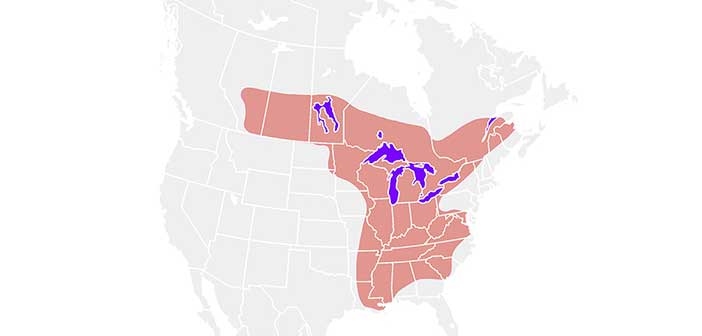MANITOULIN—Seven years later, John Bowerman of Sheguiandah is still dealing with the affects of blastomycosis—a disease that left him hospitalized at Health Sciences North in Sudbury for over three months.
Following last week’s front page article, the first in a multi-story series on the subject of blastomycosis, Mr. Bowerman reached out to The Expositor, wanting to share the news that numerous dogs have also died as a result of the fungal infection (a fact this newspaper has reported in the past and which will be covered later in this series), noting that he himself is a survivor.
He said he did not know how he came in contact with the fungal spores but said he had helped a neighbour to plane lumber but that the wood had not been mouldy. This was in 2008.
“I started having breathing problems, then lumps in my arms, under my armpits and down my arm,” Mr. Bowerman shared, noting that the lumps were excruciatingly painful.
After presenting his symptoms at the Manitoulin Health Centre (MHC), Mr. Bowerman said doctors could not give him a definitive answer as to his sickness and was sent to Sudbury for further testing. What he learned rendered him shocked and speechless. Mr. Bowerman was given the diagnosis of lung cancer, a large mass on his left lung looming on the chest x-ray, and was booked for an operation three weeks later, in November.
“It was terrible,” he said, recalling the diagnosis. “The doctor was very ticked off and said, ‘you’re a smoker’.” Mr. Bowerman is not a smoker and had to get his daughter to vouch for him with the disapproving physician.
Within those three weeks, Mr. Bowerman’s condition worsened, causing him to check in at the Little Current emergency room where Dr. Dieter Poenn was on call. He explained that Dr. Poenn took a biopsy from one of his painful arm lumps and told him to leave the numbers of anywhere he might be if not at home. With one week remaining until the operation, Mr. Bowerman received a call, asking him to come to the hospital immediately.
“They told me I had blastomycosis, but I’d never heard of it before,” he said. Almost instantly after hearing the real cause of his pain and suffering, Mr. Bowerman felt the sickest he had been to date and was sent by ambulance to Sudbury directly from the MHC. The last thing he recalls is seeing the face of nurse Judy Ferguson in the ambulance. He fell into a coma for four days.
“I don’t remember too much after that, I’m afraid,” he continued. “Sharon (Mr. Bowerman’s wife) was told that the family had better come see me now as there was a chance I wouldn’t make it.”
“I was in Sudbury for over three months—I went in just before deer season and came out at the beginning of February,” he said.
Because of the blastomycosis, Mr. Bowerman suffered nerve damage to his legs and feet—the fungal infection wreaked havoc on his circulatory system and he had to learn to walk again. “I think it affected my memory too and I still have breathing problems.”
“It can sure knock the devil out of you,” he added. “I was so sick I never had pain like that in my life.”
“I try to walk, but it just kills me—I’ve got no wind at all anymore,” Mr. Bowerman shared.
It took the Sheguiandah resident upwards of eight months to recover.
“To this day, I still don’t really understand it,” he said. “It was just all of a sudden I was sick.”
“I was so sad to hear about Gwen (Young, the woman who lost her life to blastomycosis earlier this month),” Mr. Bowerman said.
Dr. Roger Sandre is an infectious disease specialist with Health Sciences North who deals with both inpatients and outpatients suffering from the affects of blastomycosis.
He explained that once the spore (blastomyces dermatitidis) is breathed in (which is how most people develop blastomycosis, but the disease can also be contracted through a cut in the skin) it germinates in the body, turning into a yeast form.
“Generally, a certain percentage (50 percent) of patients fight off the disease and will never know while other will develop a pneumonia in the lungs ranging from mild, moderate to very severe,” Dr. Sandre explained. “It can progress very slowly, but for some, fast.”
Patients often present with a lingering cough, shortness of breath and perhaps weight loss, he added. Physicians will typically treat a patient with such symptoms with antibiotics, but because blastomycosis is a fungal disease, and not bacterial, the symptoms do not get better.
“Most of the time, it only stays in the lungs, but sometimes it will spread to the blood then seed to the skin, bones and sometimes the brain,” the doctor said.
A diagnosis comes after a sample of sputum (phlegm) or biopsy from a lesion is taken or a bronchoscopy is performed. The sample will then be checked under a microscope for a “typical yeast structure,” Dr. Sandre continued.
A sample can be grown in the lab, he added, and is not that difficult to identify. Treatment is usually with one of two anti-fungal drugs: Amphotericin B, which is administered intravenously for severe cases and itraconazole, the most common drug, which is taken orally in pill form. Treatment ranges from six to 12 months.
“It takes a long time to kill the fungus,” Dr. Sandre explained, noting that repeat x-rays will show when the infection has cleared the lungs.
Blastomycosis “mimics normal pneumonia, but can also be difficult to distinguish from caner,” the doctor admits. “Sometimes lesions from lungs look like nodules, or like cancer.” Dr. Sandre said that just last week he saw a patient who had been misdiagnosed with lung cancer, just as Mr. Bowerman had been.
In a study of 143 blastomycosis patients undertaken in Northwestern Ontario from 1988 to 1999, researchers discovered a mortality rate of 6.3 percent.
Despite the Sudbury and District Health Unit’s online literature that states that the majority of those who fall ill with the disease are immuno-compromised, Dr. Sandre said this is not the case.
“No, I don’t agree,” he said. “The majority of patients I see are just like you and me. I see it in many immuno-competent patients. In fact, the majority of patients I see are immuno-competent.”
Mike Jon Peltier of Wikwemikong considered himself immuno-competent the summer of June 2011 when he fell ill with repeat bouts of pneumonia.
Mr. Peltier, an avid hiker, said got pneumonia in June of 2011, resulting in a partially collapsed lung.
“I was told I was too slim, and this happens to people who are too skinny sometimes, but they (physicians) didn’t worry about it as my lung started filling up again,” Mr. Peltier explained.
By August he had again developed pneumonia and again suffered from a partially collapsed lung. This time, he ended up spending the night at the Manitoulin Health Centre in Little Current before being released. Six weeks later it happened again, followed by a full collapse one week later.
“This time it was a doozy,” he said, explaining that the Little Current hospital emergency doctors placed two chest tubes in his left lung to drain the fluid that had filled it.
Once a bed became available in Sudbury, five days later, Mr. Peltier was transferred to Sudbury where he remained for four more days and underwent a lobectomy to remove the upper lobe of his left lung.
“At first they thought it (repeat lung collapses and pneumonia) was because I was a smoker,” he told The Expositor. But the biopsy of his lung revealed blastomycosis.
As a result of his illness, Mr. Peltier lost 33 pounds and hasn’t been able to gain it back, only adding five pounds to his frame since 2011, and he continues to suffer from chronic fatigue.
“My breathing is perfect now and what I did to fix that was walk even more—I walked 800 kilometres last year,” he noted. “That’s what fixed me, the same thing that got me into trouble,” he laughed.
Mr. Pelter also made the decision to quit smoking this year. “I’m on day 29,” he said proudly. “I’m irritable and it’s agitating, but I had to do it.”
“Smoking made it even worse,” Mr. Peltier continued. “You combine that with blasto and it’s a recipe for disaster.”
“The doctors in Little Current are great—we’re very fortunate,” he said, encouraging those who exhibit similar symptoms to seek medical attention right away. “I should have gone a lot sooner.





